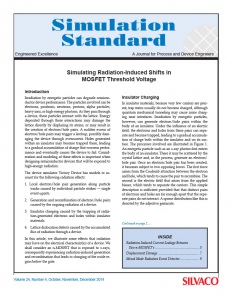Simulating Radiation-Induced Shifts in MOSFET Threshold Voltage
Introduction
Irradiation by energetic particles can degrade semiconductor device performance. The particles involved can be electrons, positrons, neutrons, protons, alpha particles, heavy ions, or high-energy photons. As they pass through a device, these particles interact with the lattice. Energy deposited through these interactions may damage the lattice directly by displacing its atoms, or may result in the creation of electron/hole pairs. A sudden excess of electron/hole pairs may trigger a latchup, possibly damaging the device through overcurrent. Holes generated within an insulator may become trapped there, leading to a gradual accumulation of charge that worsens performance and eventually causes the device to fail. Consideration and modeling of these effects is important when designing semiconductor devices that will be exposed to high-energy radiation.
The device simulator Victory Device has models to account for the following radiation effects:
- Local electron/hole pair generation along particle tracks caused by individual particle strikes — single event upsets.
- Generation and recombination of electron/hole pairs caused by the ongoing radiation of a device.
- Insulator charging caused by the trapping of radiation-generated electrons and holes within insulator materials.
- Lattice dislocation defects caused by the accumulated flux of radiation through a device.
In this article, we illustrate some effects that radiation may have on the electrical characteristics of a device. We shall consider an n-MOSFET that is exposed to x-rays, consequently experiencing radiation-induced generation and recombination that leads to charging of the oxide region below the gate.



